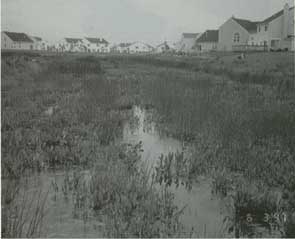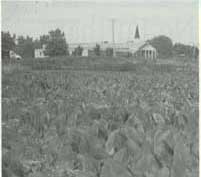|
wetland associated with a mitigation area, or for enhancement of surrounding uplands, thereby reducing the overall need for wetland creation. On-site mitigation is usually built adjacent to an existing wetland. Some of the required mitigation often is realized by enhancement of the existing wetland. Enhancement usually is simply restoration to a "better" condition by introduction of vegetation management. On-site mitigation is usually subject to specific performance standards, which outline the required wetland condition by the end of a five year period. Ecological management of the site including herbicide application, invasive shrub eradication and prescribed burning usually is a necessary element in meeting performance standards by the end of the management period. If the performance standards are met, and long-term management is arranged, the mitigation will be considered successful. Because park districts are sometimes in the position of needing to fill wetland areas, wetland issues need to be appropriately addressed. Although park districts are public entities, they are not exempt from wetland regulations. Wetland mitigation can, however, be a win-win situation for park districts when mitigation is correctly approached. With the help of experienced professionals, an on-site mitigation project can be designed to allow for development in areas of low-quality wetlands, while also preserving, expanding and enhancing areas of higher quality wetland. The result will be construction of a desired park district facility that includes green space. Thus, it is possible to improve the park district's natural areas component while also receiving credit for an on-site mitigation project. Most proposed impacts to wetlands will involve some expense in terms of permitting fees, and possibly mitigation design, construction and management. But your wetland permit experiences do not need to be like the one described in the story at the beginning of this article. Wetland issues do not have to stop projects and cause massive cost overruns. With the help of a qualified consultant and discussion with the Corps of Engineers, a plan can be developed which will integrate the park district's needs with wetland regulations. Scott Wegman |
 Photo above: Emergent vegetation in a wetland mitigation area in South Elgin, dominated by water plantain (Alms subcordatum). |
Pages:|1 ||2 | |3 ||4 | |5 ||6 | |7 ||8 | |9 ||10 | Pages:|11 ||12 | |13 ||14 | |15 ||16 | |17 ||18 | |19 ||20 |
Pages:|21 ||22 | |23 ||24 | |25 ||26 | |27 ||28 | |28a ||28b| |28c ||28d| |29 ||30 |
Pages:|31 ||32 | |33 ||34 | |35 ||36 | |37 ||38 | |39 ||40 |
Pages:|41 ||42 | |43 ||44 | |45 ||46 | |47 ||48 | |49 ||50 | Pages:|51 ||52 | |53 ||54 | |55 ||56 |
 Photo at left: Planted emergent vegetation in an existing wetland and mitigation area complex, dominated by Common Arrowhead (sagitaria latifolia).
Photo at left: Planted emergent vegetation in an existing wetland and mitigation area complex, dominated by Common Arrowhead (sagitaria latifolia).